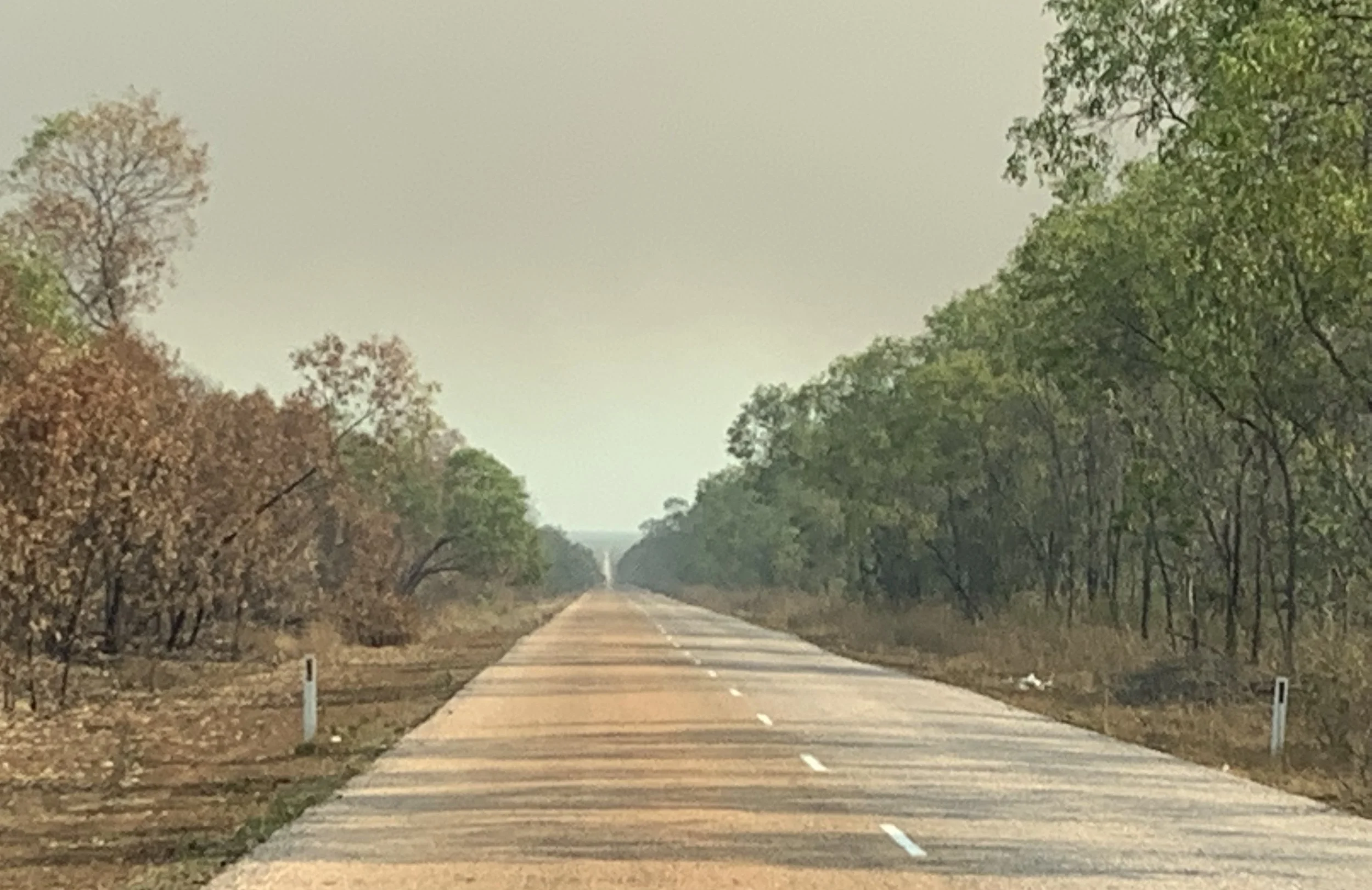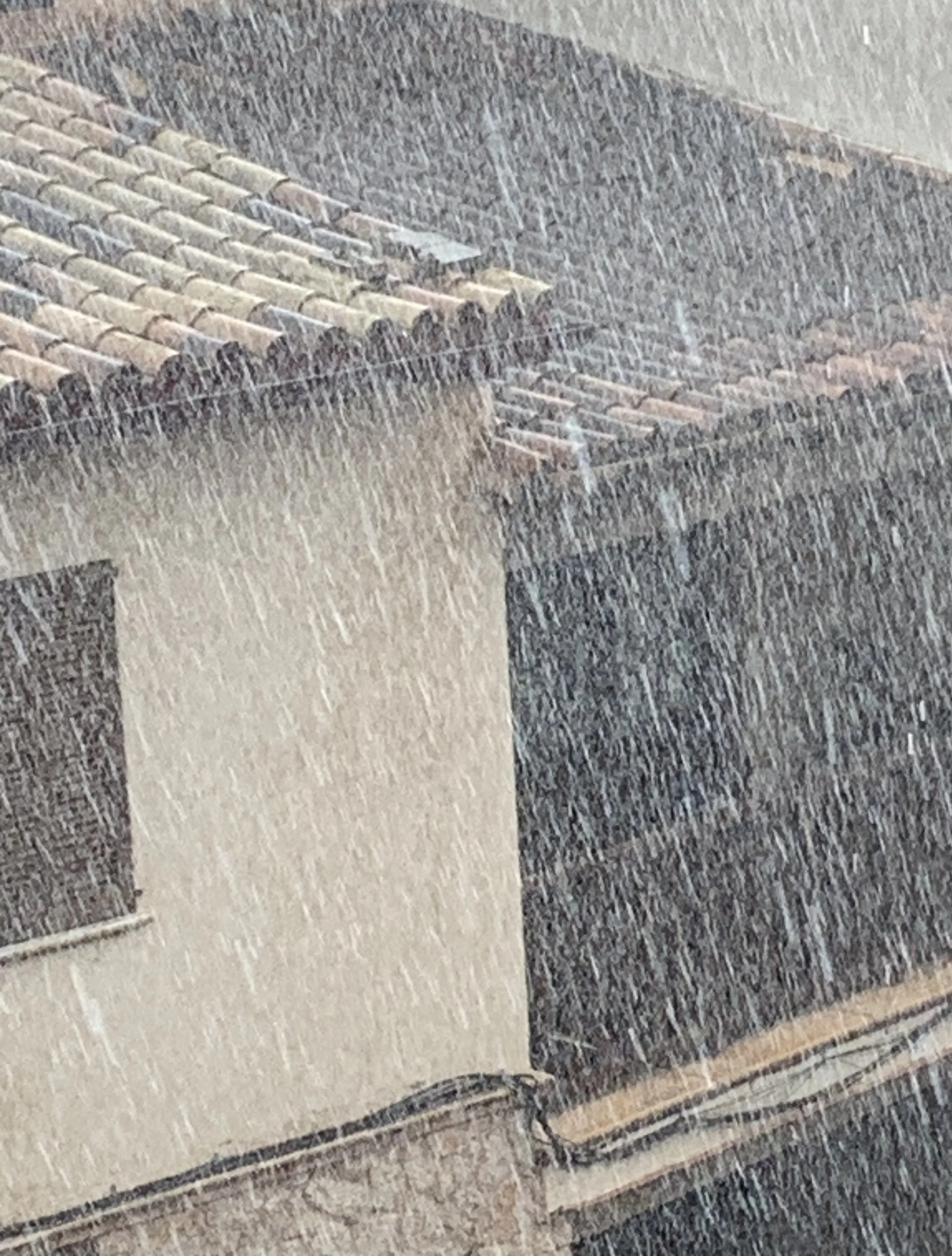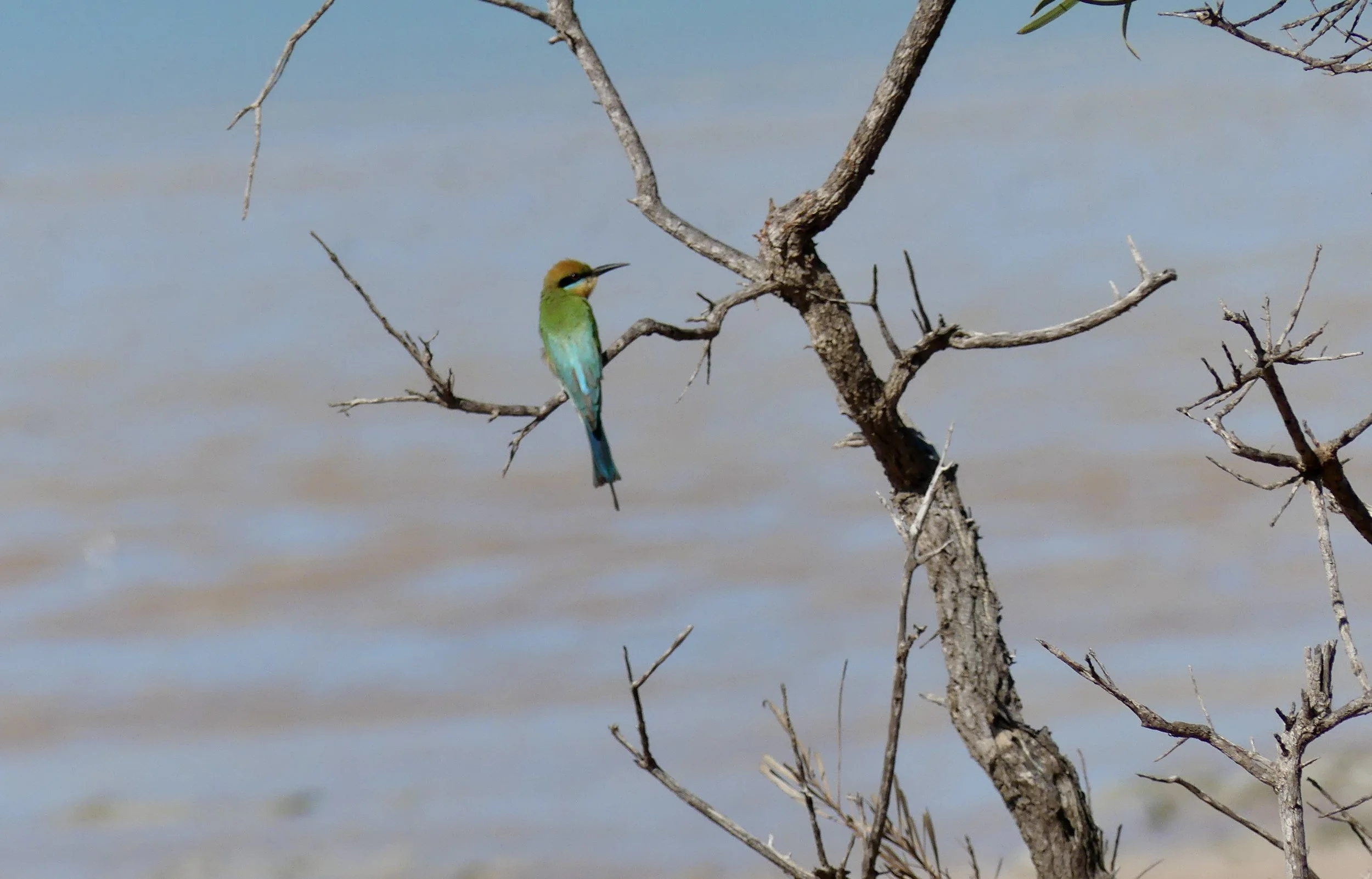Fire!
It had been warming up steadily. During the last few days of August – technically the end of the Australian winter – the diary recorded the following weather conditions:
‘Fog first thing, more humid, bloody hot’;
‘Hot, natch; we hopped from one patch of shade to another’;
‘Hot and sunny; brutal’;
‘Even hotter. Car clocked 38 degrees’.
And then, ‘Hot and sunny. Bushfire!’.
We were travelling back from Kooljaman (Cape Leveque) at the top of the pointy Dampier Peninsula, more than 200 kilometres northeast of Broome; in no particular hurry. A cloud bank hugged the horizon ahead, barely noticeable: I was driving at the time and didn’t pay much attention. When I next looked, however, something wasn’t right; the ‘cloud’ was quite a bit darker but formless; a bad-weather front, perhaps.
Featureless cloud bank?
What's that darker shape?
The image above includes something I only noticed recently, and can’t believe I didn’t see before – I’ve looked at these pictures many times. It’s impossible for me to unsee it now, of course. The image is less bright than the preceding one; there are no shadows; and there’s a distinct, darker ‘haystack’ shape within the cloud bank, to the right of the nearest cliff. Was it not cloud at all but dense smoke from a bushfire?
It wasn’t long before there were two discernibly more billowy clouds of smoke, one grey and one much darker, ahead of us down the road. I probably unconsciously accelerated at this point. We got nearer and nearer to the cloud – was it moving towards us? – when I realised there were low flames to our left at the edge of the road. Much as I would have liked to have photographed this detail, common sense got the better of me. Now I wish I’d slowed right down in the middle of the road, and got my friend to take a photo out of the nearside window. With hindsight I feel a bit of a wuss, but everything I had ever heard about what to do near fire countermanded what I’d like to have done. In this instance, caution and sensibility prevailed.
It looked like a cool burn to me, with gently licking, almost innocuous flames close to the ground. I have little experience of fire in the Australian landscape, but I once watched an Aboriginal elder light a cool burn as part of a smoking ceremony in Brisbane city centre. There was no traffic along our current road; no one passing by; no hazard warning lights; or signs informing of a prescribed burn on such-and-such a date.
When we first lived in Queensland and my friend was at work, I listened to the ABC a lot. Leading up to the fire season, which can kick off in July and last until October, but sometimes as late as February, there were extensive and detailed instructions provided by Queensland Fire and Emergency Services about how to reduce the risk to property – such as removing all potential ‘fuel’ lying around the garden or down the side of the house – and how to keep yourself, your family and animals safe.
I learned a lot from listening to the ABC during fire season, most importantly the need to do as you’re told when you’re told; if needs be, carrying nothing but the clothes you stand up in – no documents, heirlooms, jewels or other treasures unless they’re already packed and ready to pick up and go immediately.
Fire ‘business’ is huge in Australia: it is one of the most important factors to be considered in environmental management of any kind, in any region. Even if you’re not in a hot zone, lightning strikes are frequent fire starters. Many native plants and trees are uniquely adapted to cope with fire. New shoots sprout in some species surprisingly quickly; even though a plant or tree might look as if it’s burnt to a crisp, and is to all intents and purposes dead in the midst of calamitous devastation.
If fire frequently sweeps through a landscape, the regeneration of vegetation needs to be rapid, efficient and successful. Step up, epicormic buds! These lie dormant beneath bark, under the control of suppressant hormones occurring in higher, more active parts of a tree. If a tree’s crown is damaged by lightning for example, or broken in a severe gale, the epicormic buds spring into life. Epicormic re-sprouting is common in species that are part of fire-prone ecosystems, including many eucalypts, as you might expect..
There can be no doubt that some of the plants in Australian fire country are extraordinary survivors. Unfortunately, I don’t feel as if I’m any nearer to being able to identify one gum tree from another – apart from the fact that it is a gum – than when I first arrived: perhaps with the exception of the Ghost Gum, although its bark is whiter than that of the Snow Gum so the naming doesn’t seem quite right to me. Would you spot a ghost in a snowfield?
Fire line
Ash-pile skeletons of fallen trees
I recently read Fire Weather by John Vaillant, with the subtitle A True Story from a Hotter World. The book describes an ‘apocalyptic conflagration’ in a Canadian oil town, Fort McMurray in Alberta. The wildfire ignited in May 2016, and from the outset behaved unlike anything anyone had ever experienced before. It was not fully extinguished until August the following year when, finally, no more hot spots were detected in thermal surveys.
‘Damage’ no longer adequately described the consequences of that fire; obliteration was the word. 5,960 square kilometres (2,300 square miles) of boreal forest burned; more than 2,500 homes and other buildings were destroyed. ‘No one’s ever seen anything like this,’ Fort McMurray’s fire chief said at one of many press conferences during the ordeal. ‘The way this thing happened, the way it travelled, the way it behaved – this is rewriting the book.’ His face was by this time ashen and weary; a man too long without sleep yet driven by his responsibility while adjusting to conditions in a post-catastrophic world. Despite all his experience, I imagined he no longer knew exactly what to do for the best.
Several years after Fort McMurray, energy-guzzling nations are as complicit in fossil fuel growth as ever they were; their greedy, disingenuous governments are as self-delusional as ever they were. And all the while the evidence of impending climate havoc mounts, as undeniable and inevitable as the planet’s already-rising temperatures.
Fire survivor
Ash skeleton
In the summer of 2019-20 we were living in Melbourne. Higher-than-usual temperatures and drier-than-normal earth sparked fires throughout the state of Victoria. Things were particularly grim in East Gippsland, and smoke from these fires drifted as far west as Melbourne, where air quality was rated hazardous by the Environmental Protection Agency Victoria, ranking among the worst in the world some days.
Where’s the city gone?
Of all nature’s forces on earth, the prospect of fire is the most terrifying. Living in Australia taught me that planetary extremes should never be underestimated. We experienced 40-degree-heading temperatures combined with debilitating humidity; winds you could barely stand upright in; and drenching, pummeling downpours. Australians respected the information they received over national radio and calmly acted accordingly.










